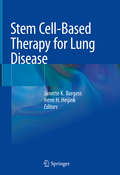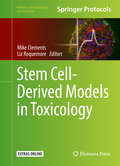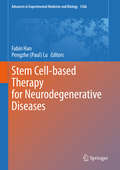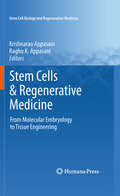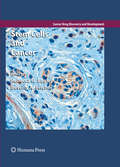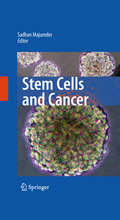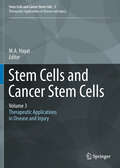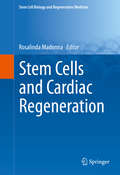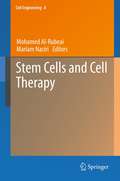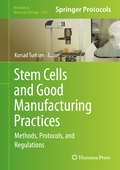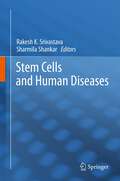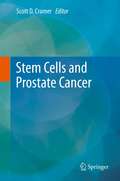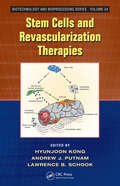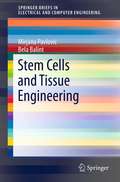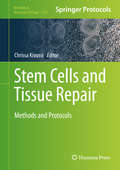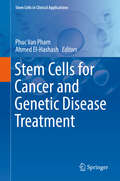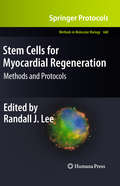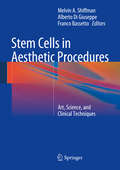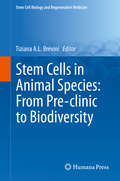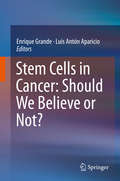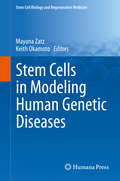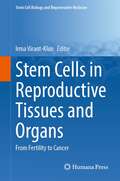- Table View
- List View
Stem Cell-Based Therapy for Lung Disease
by Janette K. Burgess Irene H. HeijinkThis book presents state-of-the-art pre-clinical models and clinical applications of stem-cell-based therapies applied to different lung diseases, with a special focus on the translation of bench data into clinical studies. Starting with the assumption that abnormal lung tissue repair and regeneration has emerged as the driving force underlying pathogenesis and progression in many lung diseases, it sheds new light on the potential of stem/stromal cells as drivers of repair and sources of reparative factors in the lung. The first part of the book offers an overview of stem cell types and mechanisms involved in lung development, homeostasis, repair and regeneration, and reveals the crucial role of the extracellular matrix within the lung microenvironment. In the second part, leading experts present the latest pre-clinical evidence and clinical applications of stem-cell-based therapies in a wide variety of lung diseases, ranging from COPD and lung fibrosis to other rare lung diseases. The last section discusses stem cell delivery systems and devices, such as aerosolised spray application. This book appeals to pneumologists, stem cell and matrix biologists, as well as bioengeneers with a special interest in regenerative medicine applied to pulmonary diseases.
Stem Cell-Derived Models in Toxicology
by Mike Clements Liz RoquemoreThis detailed volume brings together a diverse collection of stem cell-derived model-based toxicity assays, from those routinely used to those deemed to have considerable potential. With a focus on differentiated tissues, the chapters explore numerous cardiotoxicity applications as well as coverage of neurotoxicity, hepatotoxicity, and more. Written for the Methods in Pharmacology and Toxicology series, the contents of this book aim to enable adoption of these protocols in laboratories that are interested in entering the field as well as to facilitate the transfer of best practices between laboratories that are already actively pursuing these technologies. Authoritative and cutting-edge, Stem Cell-Derived Models in Toxicology serves as a vital resource for researchers aiming to improve risk assessment in drug discovery and design.
Stem Cell-based Therapy for Neurodegenerative Diseases (Advances in Experimental Medicine and Biology #1266)
by Fabin Han Pengzhe Paul LuThis book reviews the state-of-the-art in stem-cell-based therapies for neurodegenerative diseases, and highlights advances in both animal models and clinical trials. It comprehensively discusses most neurodegenerative diseases, including such as Parkinson's, Alzheimer's and Huntington’s diseases, amyotrophic sclerosis, multiple sclerosis, muscular dystrophy and retinal degeneration, in which stem cells could potentially be used for therapy in the future. It also addresses the challenges and problems relating to the translation of stem-cell-based therapies into treatments. As such, the book will appeal to research scientists, physicians, graduate students, and medical professionals in the field of stem cells, neuroscience, neurology, neurorestoratology and major neurological disorders.
Stem Cells & Regenerative Medicine
by Krishnarao Appasani Raghu K. AppasaniDefined as, "The science about the development of an embryo from the fertilization of the ovum to the fetus stage," embryology has been a mainstay at universities throughout the world for many years. Throughout the last century, embryology became overshadowed by experimental-based genetics and cell biology, transforming the field into developmental biology, which replaced embryology in Biology departments in many universities. Major contributions in this young century in the fields of molecular biology, biochemistry and genomics were integrated with both embryology and developmental biology to provide an understanding of the molecular portrait of a "development cell." That new integrated approach is known as stem-cell biology; it is an understanding of the embryology and development together at the molecular level using engineering, imaging and cell culture principles, and it is at the heart of this seminal book. Stem Cells and Regenerative Medicine: From Molecular Embryology to Tissue Engineering is completely devoted to the basic developmental, cellular and molecular biological aspects of stem cells as well as their clinical applications in tissue engineering and regenerative medicine. It focuses on the basic biology of embryonic and cancer cells plus their key involvement in self-renewal, muscle repair, epigenetic processes, and therapeutic applications. In addition, it covers other key relevant topics such as nuclear reprogramming induced pluripotency and stem cell culture techniques using novel biomaterials. A thorough introduction to stem-cell biology, this reference is aimed at graduate students, post-docs, and professors as well as executives and scientists in biotech and pharmaceutical companies.
Stem Cells Heterogeneity in Cancer (Advances in Experimental Medicine and Biology #1139)
by Alexander BirbrairThis book presents a comprehensive discussion on the heterogeneity existing between different types of stem cells within the same tissue, for several types of cancers, e.g. glioblastoma stem cells. Recent developments have revealed completely different roles of distinct stem cells within the same organ.Thus, Stem Cells Heterogeneity in Cancer provides a timely update us on the current information on stem cells heterogeneity in various tissues. It also provides a solid foundation of the history of stem cells from specific tissues and the current applications of this knowledge in regenerative medicine. When taken as a whole, alongside its companion volumes Stem Cells Heterogeneity – Novel Concepts, and Stem Cells Heterogeneity in Different Organs, these three books present a comprehensive reference on stem cell heterogeneity in various tissues and current and future applications for regenerative medicine. It is essential reading for advanced cell biology students as well as researchers in stem cells and clinicians.
Stem Cells and Cancer
by Rebecca G. Bagley Beverly A. TeicherSignificance of Stem Cells to Tumor Development Cancer stem cells remain a controversial topic and the criteria that define cancer stem cells are continuing to evolve. A recent surge in stem cell research has ignited a field of discovery into many human diseases including diabetes, neuropathologies, and cancer. By replacing specific differentiated cells that have either been lost or died, stem cell therapy proves to be a very promising approach to the treatment of many debilitating diseases. Though stem cells may provide therapeutic benefit under certain conditions, they are also often implicated in the initiation, progression, and therapeutic resistance of malignant disease. This first edition of Stem Cells and Cancer is intended to give a current perspective on the role of stem cells in cancer and strategies for novel therapies directed toward tumor stem cells. The current cancer stem cell hypothesis is presented in several chapters with distinctions made between the hierarchical and stochastic models of tumor cell development. "Stemness," self-renewal, pluripotency, clonality, and tumorigenicity are important concepts applied towards defining cancer stem cells. Signaling pathways such as Wnt, Sonic Hedgehog, Notch, and Bmi-1 that are involved in differentiation, proliferation, and survival are implicated in the malignant process. Additional chapters address the identification of cancer stem cell populations through the evaluation of molecular markers such as CD133, CD44, and CD24, for example, or by Hoescht dye exclusion to recognize 'side populations.' Mesenchymal and hematopoietic stem cells are described as well as mouse models that are employed to elucidate the properties and functionality of stem cells in cancer and the stem cell niche. This book encompasses a wide variety of human cancers that include but are not limited to leukemia, gliomas, breast, and prostate cancers. Resistance to conventional therapies, genetic versus epigenetic changes that affect therapeutic response and strategies to prevent disease recurrence are challenges have been incorporated into this volume. Stem Cells and Cancer represents a compendium of cutting edge research by experts in the field and will be instrumental in the study of this intriguing line of investigation for many years to come. Rebecca Bagley is a senior scientist at Genzyme Corporation and has worked in the biotechnology industry for 20 years with degrees in biology from Wellesley College and Harvard University. Her expertise in drug development spans a wide range of approaches including immunotherapies, gene and protein therapies, and small molecule delivery with publications in journals such as Molecular Cancer Therapeutics, Cancer Research, and Microvascular Research . Her current research focuses on stem cells, tumor vasculature, and target validation. Dr. Beverly A. Teicher is Vice President of Oncology Research at Genzyme Corporation. Dr. Teicher completed a PhD in Bioorganic Chemistry at the Johns Hopkins University and postdoctoral training at Yale University School of Medicine. Dr. Teicher joined Dana-Farber Cancer Institute as an Assistant Professor of Pathology and rose to Associate Professor of Medicine and Radiation Therapy, Harvard Medical School at Dana-Farber Cancer Institute and Joint Center for Radiation Therapy. Dr. Teicher is an active member of the international scientific community having authored or co-authored more than 400 scientific publications. She has edited eight books, is senior editor for the journal Clinical Cancer Research and is series editor for the Cancer Drug Discovery and Development book series.
Stem Cells and Cancer
by Sadhan MajumderCancer is a primary cause of human mortality worldwide. Despite decades of basic and clinical research, the outcome for most cancer patients is still dismal. Some stumbling blocks to developing effective therapy include the heterogeneity of cancer tissues, the lack of knowledge about the critical molecular mechanisms in cancer tissues (which are typically aberrant compared with mechanisms in normal tissue), and the lack of good mechanism-based therapeutic approaches. The recent findings that most cancers contain a small fraction of self-renewing, differentiation-blocked stem cell-like cells (cancer stem cells) and that it is these cells--and not the major bulk of the tissue--that are the root cause for cancer initiation and metastasis have also highlighted the need to change our approach to cancer therapy. The objectives of this book, therefore, would be to impart up-to-date information about the role of stem cells in the development of normal and cancerous tissue, the mechanisms that differentiate normal from cancerous functions, and the use of these findings in developing mechanism-based therapies.
Stem Cells and Cancer Stem Cells, Volume 13
by M. A. HayatThis is the thirteenth volume in a series which presents current understanding of stem cells and cancer stem cells. This book presents many relevant topics including the different sources of cancer stem cells: the features, roles and clinical potential of stem cells emerge from engaging with this comprehensive work. Chapters explore molecular mechanisms underlying human somatic cell reprogramming to generate induced pluripotent stem cells and provide expert discussion of the advantages and limitations of applications of some of the stem cell types (pluripotent stem cells, neural stem cells). Many advances are explored, including the importance of stem cell markers in diagnosis, the role of stem cells in angiogenesis and a method for isolating multi potent endothelial-like cells from human adipose tissue, to name a few. Readers will also find a consideration of mathematical models and other quantitative tools which could facilitate research and discovery in the field. The editor's preface to the book and the series is particularly helpful in introducing the work presented in this volume. The detailed overviews, practical experience and insights of international expert authors presented in this handbook will be of value to both professional practitioners and scholars in basic research.
Stem Cells and Cardiac Regeneration
by Rosalinda MadonnaThis book provides an update of recent advances in the basic and clinical applications of cell-based therapies for myocardial repair and regeneration in ischemic heart disease (IHD) and heart failure (HF). The first sections of the book illuminate basic aspects of stem cells such as definitions, isolation criteria and characterization of embryonic and adult stem cells, as well as pluripotent stem cells and tissue specific progenitor and stem cells. In the following section, the text examines the role of critical regulators of stem cell differentiation in myocardial regeneration, that include circadian rhythyms, microRNAs, epigenetics, microvescicles, and exosomes. The text concludes with a review of the use of stem/progenitor cells in cardiac regeneration and discuss current controversies, unresolved issues, challenges, and future directions. Stem Cells and Cardiac Regeneration is addressed to a wide audience consisting of cardiologists, clinicians, and research scientists, who will learn new concepts in cardiovascular regeneration and repair with special focus on molecular mechanisms and therapeutic potential for cardiovascular regeneration.
Stem Cells and Cell Therapy
by Mohamed Al-Rubeai Mariam NaciriWith the discovery of stem cells capable of multiplying indefinitely in culture and differentiating into many other cell types in appropriate conditions, new hopes were born in repair and replacement of damaged cells and tissues. The features of stem cells may provide treatment for some incurable diseases with some therapies are already in clinics, particularly those from adult stem cells. Some treatments will require large number of cells and may also require multiple doses, generating a growing demand for generating and processing large numbers of cells to meet the need of clinical applications. With this in mind, our aim is to provide a book on the subject of stem cells and cell therapy for researchers and students of cell biotechnology, bioengineering and bioproduction. This book is exceptional as it teaches researchers stem cells and cell therapy in that it covers the concepts and backgrounds necessary so that readers get a good understanding of the production of stem cells. The book covers three topics: The basics of stem cells and cell therapy, the use of stem cells for the treatment of human diseases, and stem cell processing. It includes chapters on neural and vascular stem vascular stem cell therapy, expansion engineering of embryonic stem cells, stem cell based production of blood cells and separation technologies for stem cells and cell therapy products. It is an informed and informative presentation of what modern research, science and engineering have learned about stem cells and their production and therapies. Addressing both the medical and production issues, this book is an invaluable contribution to having an academic and industrial understanding with respect to R&D and manufacturing of clinical grade stem cells.
Stem Cells and Good Manufacturing Practices
by Kursad TurksenThis volume collects a series of protocols describing the kinds of infrastructures, training, and standard operating procedures currently available to actualize the potential of stem cells for regenerative therapies. Stem Cells and Good Manufacturing Practices: Methods, Protocols, and Regulations pulls together key GMP techniques from laboratories around the world. Written in the highly successful Methods in Molecular Biology series format, chapters include introductions to their respective topics, lists of the necessary materials, step-by-step, readily reproducible laboratory protocols, and tips on troubleshooting and avoiding known pitfalls. Inclusive and authoritative, Stem Cells and Good Manufacturing Practices: Methods, Protocols, and Regulations will be an invaluable resource to both basic and clinical practitioners in stem cell biology.
Stem Cells and Human Diseases
by Rakesh K. Srivastava Sharmila ShankarThe main objective of this book is to provide a comprehensive review on stem cells and their role in tissue regeneration, homeostasis and therapy. In addition, the role of cancer stem cells in cancer initiation, progression and drug resistance are discussed. The cell signaling pathways and microRNA regulating stem cell self-renewal, tissue homeostasis and drug resistance are also mentioned. Overall, these reviews will provide a new understanding of the influence of stem cells in tissue regeneration, disease regulation, therapy and drug resistance in several human diseases.
Stem Cells and Prostate Cancer
by Scott D. CramerRecent evidence demonstrates that normal prostate tissue contains stem cells. There is also accumulating evidence that prostate cancer contains a population of cells with stem cell-like characteristics referred to as cancer stem cells, or tumor initiating cells. Both the normal prostate stem cell and cancer stem cell populations have important implications for the generation, therapeutic targeting, and prevention of prostate cancer. The purpose of this book is to explore the role of stem cells in prostate cancer, which is becoming an increasingly hot trend in cancer research.
Stem Cells and Revascularization Therapies
by Lawrence B. Schook Hyunjoon Kong Andrew J. PutnamIn the last few decades, significant advancements in the biology and engineering of stem cells have enabled progress in their clinical application to revascularization therapies. Some strategies involve the mobilization of endogenous stem cell populations, and others employ cell transplantation. However, both techniques have benefited from multidis
Stem Cells and Tissue Engineering
by Bela Balint Mirjana PavlovicStem cells are the building blocks for all other cells in an organism. The human body has about 200 different types of cells and any of those cells can be produced by a stem cell. This fact emphasizes the significance of stem cells in transplantational medicine, regenerative therapy and bioengineering. Whether embryonic or adult, these cells can be used for the successful treatment of a wide range of diseases that were not treatable before, such as osteogenesis imperfecta in children, different forms of leukemias, acute myocardial infarction, some neural damages and diseases, etc. Bioengineering, e.g. successful manipulation of these cells with multipotential capacity of differentiation toward appropriate patterns and precise quantity, are the prerequisites for successful outcome and treatment. By combining in vivo and in vitro techniques, it is now possible to manage the wide spectrum of tissue damages and organ diseases. Although the stem-cell therapy is not a response to all the questions, it provides more and more answers every day. Stem Cells and Tissue Engineering is a concise review on the functional, phenotypic, regenerative, transplantational and curative aspects of a stem cell's entity. It is critical and encouraging at the same time, providing truthful and appropriate samples from the practice and research that can lead toward optimal use of this immense source of adjuvant and curative therapy in human pathology. Written by a clinician and a researcher, who are currently teaching what they are doing, it is recommended as a teaching tool along with an original textbook.
Stem Cells and Tissue Repair
by Chrissa KioussiStem Cells and Tissue Repair: Methods and Protocols presents in-depth methods for the three major approaches of rejuvenating an aging or sick body: latent regenerative capacity stimulated in a targeted way, replacement organs grown de novo and surgically implanted, and tissue surgically implanted and coaxed to integrate and restore problem areas. The first approach taps into the latent regenerative capacity of particular tissues, such as muscle, skin, fat, or bone marrow. The second approach induces and grows pluripotent stem cells, drives their differentiation along certain pathways such as germ layers, neural crest, liver, teeth or retina, and cultures organs such as pancreas and heart. While the third approach involves various engraftment techniques for neural tissue. Written in the successful Methods in Molecular Biology series format, chapters include introductions to their respective topics, lists of the necessary materials and reagents, step-by-step, readily reproducible protocols, and notes on troubleshooting and avoiding known pitfalls. Authoritative and easily accessible, Stem Cells and Tissue Repair: Methods and Protocols provides state-of the-art methods descriptions and the references therein that will provide a suitable starting point for exploring the vast literature that has already developed for regenerative medicine.
Stem Cells for Cancer and Genetic Disease Treatment (Stem Cells in Clinical Applications)
by Phuc Van Pham Ahmed El-HashashThis invaluable resource discusses insights ranging from basic biological mechanisms of various types of stem cells through the potential applications in the treatment of human diseases, including cancer and genetic disorders. These discoveries are placed within the structural context of tissue and developmental biology in sections dealing with recent advances in understanding different types of stem cell biology and their potential applications in tissue repair and regeneration and in the treatment different types of human cancer and genetic diseases or disorders.Stem Cells for Cancer and Genetic Disease Treatment and the other books in the Stem Cells in Clinical Applicationsseries will be invaluable to scientists, researchers, advanced students and clinicians working in stem cells, regenerative medicine or tissue engineering as well as cancer or genetics research.
Stem Cells for Myocardial Regeneration
by Randall J. LeeThere is currently a great deal of enthusiasm surrounding organ regeneration, which mainly comes from the potential pleuripotency of stem cells to differentiate into various tissue types. In Stem Cells for Myocardial Regeneration: Methods and Protocols, expert researchers explore exciting new developments in the field of regenerative medicine, focusing both on the benefits of using stem cells in myocardial repair and regeneration and on the challenges associated with making this a mainstream therapy. Chapters consider the optimal cell type for myocardial repair, examine the developmental processes of the human heart in order to develop strategies for regeneration, consider ex-vivo optical mapping and in vivo electrophysiology studies, and investigate the effects of the extracellular matrix on stem cell renewal and differentiation. Composed in the highly successful Methods in Molecular Biology(tm) series format, each chapter contains a brief introduction, step-by-step methods, a list of necessary materials, and a Notes section which shares tips on troubleshooting and avoiding known pitfalls. Ground-breaking and current, Stem Cells for Myocardial Regeneration: Methods and Protocols, is an essential guide for scientists, translational investigators, and cardiologists alike, providing readers with a means to evaluate the efficacy and safety of adopting stem cells as the standard for myocardial regeneration.
Stem Cells in Aesthetic Procedures
by Melvin A. Shiffman Alberto Di Giuseppe Franco BassettoInterest in the use of stem cells in aesthetic procedures has been increasing rapidly, reflecting the widespread acknowledgment of the tremendous potential of stem cell fat transfer. This is, however, the first book to be devoted entirely to the subject. The book opens by reviewing the history of the development of pluripotent stem cells and the results of research into the biochemistry and physiology of stem cells. Adipose tissue anatomy and survival are discussed and the wide range of aesthetic procedures involving stem cell fat transfer are then described in detail. These procedures relate to the face, breast, buttocks, legs, hands, penis and Poland syndrome. In addition, potential risks and complications are identified. The book has been written by leading experts and will be an invaluable source of information for students, beginners and experienced surgeons in a range of specialties.
Stem Cells in Animal Species: From Pre-clinic to Biodiversity
by Tiziana A.L. BreviniThis volume focuses on stem cell research and disease modeling in non-murine species. The book is divided into three parts: Stem Cells for Pre-Clinical Models, Stem Cells in Non-Conventional Species, and Stem Cell Banking for the Future. The first section presents an overview of the different pre-clinical stem cell models recently created in animal species, including the porcine model for heart failure, iPSC in large animal species, Duchenne muscular dystrophy and canine embryo-derived stem cells and modeling for human diseases. This section also discusses the potential advantages and applications of these models. The second part of this book describes recent efforts to use stem cells for preserving endangered species, including the snow leopard and coral reefs. From this perspective, stem cells are an invaluable tool to preserve bio-diversities. Frozen cells and gametes can be obtained from animals at risk of extinction and even from microorganisms and corals suffering from heavy changes in the eco-system; this may allow the cultivation of a generation of stem cell lines and represents an exciting opportunity to support and ensure the conservation of precious varieties of living creatures. This discussion leads easily into the third section, which discusses stem cell banking as a way of safeguarding these endangered species.
Stem Cells in Cancer: Should We Believe or Not?
by Enrique Grande Luis Antón AparicioThis volume explores the latest developments in a novel area of molecular biology and a hot topic in the field of oncology: cancer stem cells. These chapters from expert contributing authors present concepts such as the universal stem cell, new molecular pathways, new targeted agents, the different roles that cancer stem cells seem to have according to the organ they are placed in, and the future role that targeting cancer stem cells may have in the management of patients in the clinic. Exploring the latest research including new data from randomized trials, this book examines important proposals over the origin of cancer stem cells such as the possibility that cancer stem cells may arise from mutated stem cells or a fully differentiated cell that may undergo several mutations that drive it back to a stem-like state. The authors consider the role that stem cells seem to have in the onset, development and resistance to classical antitumoral treatments of cancer and discuss possible potential future treatment modalities for the management of advanced cancer patients. The question, "Are stem cells involved in cancer?" may not have a simple answer, but ongoing investigations, in-depth consideration and a broad spectrum of information can be found in this book, allowing the reader to arrive at his or her own answer. This book will appeal to researchers in the field of oncology and cancer research and biomedical scientists with an interest in stem cells.
Stem Cells in Modeling Human Genetic Diseases
by Mayana Zatz Oswaldo Keith OkamotoWhile most stem cell books focus on basic aspects and/or cell therapy, this book emphasizes the relevance of stem cells obtained from patients, the so-called "patients in a petri dish" as tools to investigate human genetic diseases for which there are no available effective treatment. Chapters embrace several examples of the use of iPS cell technology, a recent Nobel Prize-winning scientific breakthrough, to obtain patient-specific pluripotent cells from which many types of specialized cells involved in a particular disease can be generated, including psychiatric and neurodegenerative disorders, muscular dystrophies, laminopathies, among others. The text is a current and timely resource for postgraduate students, scientists and clinicians, interested in applications of this rapidly developing field of research in disease modeling, drug development, and emerging issues that it brings to regenerative medicine.
Stem Cells in Neuroendocrinology
by Yves Christen Donald PfaffThis volume starts with an elementary introduction covering stem cell methodologies used to produce specific types of neurons, possibilities for their therapeutic use, and warnings of technical problems. In addition the authors report successes in achieving the derivation of a specific type of neuron. The dopamine neuron offers an important example and is discussed in more detail. Additional chapters cover problems obviously approachable with cells derived from stem cells, including their need in surgeries for pituitary cancers. The last chapter provides an overview of this particular field of research and presents a vision for its future directions.
Stem Cells in Reproductive Medicine
by Carlos Simón Md Phd Antonio Pellicer Renee Reijo Pera Carlos Simón Antonio PellicerStem cell science has the potential to impact human reproductive medicine significantly - cutting edge technologies allow the production and regeneration of viable gametes from human stem cells offering potential to preciously infertile patients. Written by leading experts in the field Stem Cells in Reproductive Medicine brings together chapters on the genetics and epigenetics of both the male and female gametes as well as advice on the production and regeneration of gene cells in men and women, trophoblasts and endometrium from human embryonic and adult stem cells. Although focussing mainly on the practical elements of the use of stem cells in reproductive medicine, the book also contains a section on new developments in stem cell research. The book is essential reading for reproductive medicine clinicians, gynecologists and embryologists who want to keep abreast of practical developments in this rapidly developing field.
Stem Cells in Reproductive Tissues and Organs: From Fertility to Cancer (Stem Cell Biology and Regenerative Medicine #70)
by Irma Virant-KlunThis contributed volume gathers the latest knowledge in the field of stem cells in human reproductive organs, as well as animal models, and to consider the possibility of using this knowledge for clinical purposes. The scope of the book covers both clinical and basic knowledge of stem cells in both reproductive medicine (gynecology and obstetrics) and regenerative medicine as well as cellular and molecular medicine and reproductive biology. Chapters on basic stem cell knowledge in human reproductive tissues and organs or animal models are included, as well as clinical knowledge on their role in the manifestation of infertility and cancer and their clinical use.
